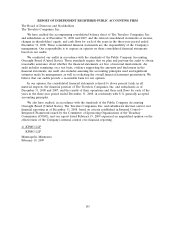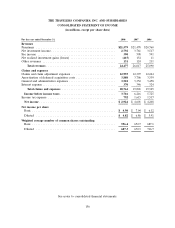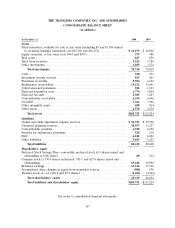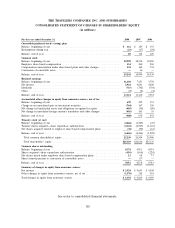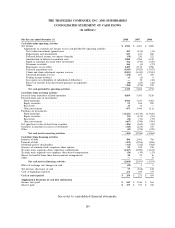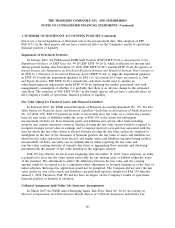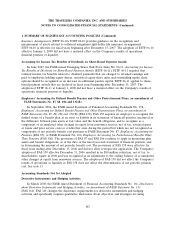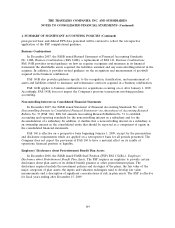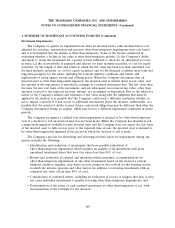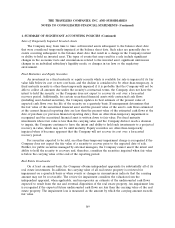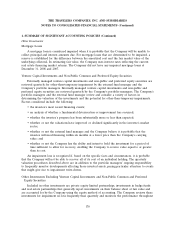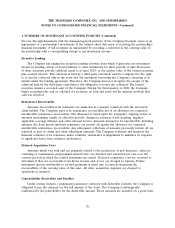Travelers 2008 Annual Report Download - page 174
Download and view the complete annual report
Please find page 174 of the 2008 Travelers annual report below. You can navigate through the pages in the report by either clicking on the pages listed below, or by using the keyword search tool below to find specific information within the annual report.THE TRAVELERS COMPANIES, INC. AND SUBSIDIARIES
NOTES TO CONSOLIDATED FINANCIAL STATEMENTS (Continued)
1. SUMMARY OF SIGNIFICANT ACCOUNTING POLICIES (Continued)
Insurance Arrangements (EITF 06-10). EITF 06-10 provides guidance on the recognition and
measurement of assets related to collateral assignment split-dollar life insurance arrangements.
EITF 06-10 is effective for fiscal years beginning after December 15, 2007. The adoption of EITF 06-10
effective January 1, 2008 did not have a material effect on the Company’s results of operations,
financial position or liquidity.
Accounting for Income Tax Benefits of Dividends on Share-Based Payment Awards
In June 2007, the FASB issued Emerging Issues Task Force Issue No. 06-11, Accounting for Income
Tax Benefits of Dividends on Share-Based Payment Awards (EITF 06-11). EITF 06-11 requires that
realized income tax benefits related to dividend payments that are charged to retained earnings and
paid to employees holding equity shares, nonvested equity share units and outstanding equity share
options should be recognized as an increase in additional paid-in capital. EITF 06-11 applies to share-
based payment awards that are declared in fiscal years beginning after December 15, 2007. The
adoption of EITF 06-11 at January 1, 2008 did not have a material effect on the Company’s results of
operations, financial position or liquidity.
Employers’ Accounting for Defined Benefit Pension and Other Postretirement Plans, an amendment of
FASB Statements No. 87, 88, 106 and 132(R)
In September 2006, the FASB issued Statement of Financial Accounting Standards No. 158,
Employers’ Accounting for Defined Benefit Pension and Other Postretirement Plans, an amendment of
FASB Statements No. 87, 88, 106 and 132(R) (FAS 158). FAS 158 requires an employer to recognize the
funded status of a benefit plan as an asset or liability in its statement of financial position, measured as
the difference between plan assets at fair value and the benefit obligation, and to recognize as a
component of accumulated other changes in equity from nonowner sources, net of tax, actuarial gains
or losses and prior service costs or credits that arise during the period but which are not recognized as
components of net periodic benefit cost pursuant to FASB Statement No. 87, Employers’ Accounting for
Pensions (FAS 87), or FASB Statement No. 106, Employers’ Accounting for Postretirement Benefits Other
Than Pensions (FAS 106). The provisions of FAS 87 and FAS 106 continue to apply in measuring plan
assets and benefit obligations, as of the date of the fiscal year-end statement of financial position, and
in determining the amount of net periodic benefit cost. The provisions of FAS 158 were effective for
fiscal years ending after December 15, 2006 and did not allow retrospective application. The Company’s
adoption of FAS 158 effective December 31, 2006 resulted in an $80 million reduction, net of tax, to
shareholders’ equity in 2006 and was recognized as an adjustment to the ending balance of accumulated
other changes in equity from nonowner sources. The adoption of FAS 158 did not affect the Company’s
results of operations or liquidity as FAS 158 does not affect the determination of net periodic pension
cost. See note 13.
Accounting Standards Not Yet Adopted
Derivative Instruments and Hedging Activities
In March 2008, the FASB issued Statement of Financial Accounting Standards No. 161, Disclosures
about Derivative Instruments and Hedging Activities, an Amendment of FASB Statement No. 133
(FAS 161). FAS 161 changes the disclosure requirements for derivative instruments and hedging
activities and specifically requires qualitative disclosures about objectives and strategies for using
162





